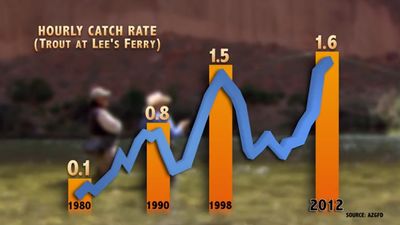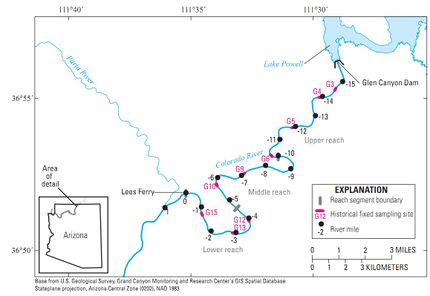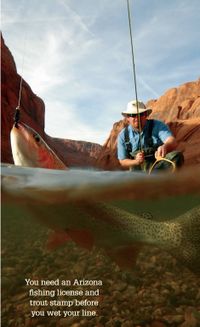Difference between revisions of "FISHERY"
Cellsworth (Talk | contribs) |
Cellsworth (Talk | contribs) |
||
| Line 47: | Line 47: | ||
|style="color:#000;"| | |style="color:#000;"| | ||
| − | + | |- | |
| + | ! <h2 style="margin:0; background:#cedff2; font-size:120%; font-weight:bold; border:1px solid #a3b0bf; text-align:left; color:#000; padding:0.2em 0.4em;">[http://leesferry.com/river-report/?utm_source=+12%2F15%2F14&utm_campaign=Lees+Ferry+Mailing&utm_medium=email: Fishing Report] </h2> | ||
| + | |- | ||
| + | |style="color:#000;"| | ||
| − | + | APRIL 26 , 2016 | |
UPRIVER REPORT | UPRIVER REPORT | ||
| Line 100: | Line 103: | ||
WALK-IN SUMMARY | WALK-IN SUMMARY | ||
| − | We are hearing a more positive reports on the walk-in fishing. The fishing has been improving weekly and keep in mind that the best fishing is on the lower water days…Saturday and Sunday. Seeing some epic midge hatches which should increase into May. | + | We are hearing a more positive reports on the walk-in fishing. The fishing has been improving weekly and keep in mind that the best fishing is on the lower water days…Saturday and Sunday. Seeing some epic midge hatches which should increase into May. |
| − | + | ||
| − | + | ||
| − | + | ||
| − | + | ||
| − | + | ||
| − | + | ||
| − | + | ||
| − | + | ||
| − | + | ||
| − | + | ||
| − | + | ||
| − | + | ||
SPIN FISHING SUMMARY. | SPIN FISHING SUMMARY. | ||
| Line 136: | Line 127: | ||
Definition of '''Blue Ribbon''' fishery: [http://en.m.wikipedia.org/wiki/Blue_Ribbon_fisheries Definition LINK] | Definition of '''Blue Ribbon''' fishery: [http://en.m.wikipedia.org/wiki/Blue_Ribbon_fisheries Definition LINK] | ||
| − | *[[File:Hourly Catch Rate- Lees Ferry- GRAPH.jpg| | + | *[[File:Hourly Catch Rate- Lees Ferry- GRAPH.jpg|400px]] |
*[http://www.gcdamp.gov/fs/LeesFTF.pdf GCDAMP- Public Outreach- Lees Ferry Trout Fishery] | *[http://www.gcdamp.gov/fs/LeesFTF.pdf GCDAMP- Public Outreach- Lees Ferry Trout Fishery] | ||
---- | ---- | ||
| Line 145: | Line 136: | ||
*In 1991 the Arizona Game and Fish stocked large trout instead of fingerling trout to maintain the Lees Ferry trout sport fishery ''(090711_Minority Report to TWG_FFF_Mark Steffen)'' | *In 1991 the Arizona Game and Fish stocked large trout instead of fingerling trout to maintain the Lees Ferry trout sport fishery ''(090711_Minority Report to TWG_FFF_Mark Steffen)'' | ||
| − | [[File:MAP- Lees Ferry- Negative RM.jpg | | + | [[File:MAP- Lees Ferry- Negative RM.jpg |430px]] |
| Line 218: | Line 209: | ||
|- | |- | ||
|style="color:#000;"| | |style="color:#000;"| | ||
| − | [[Image:Vermillion Video- Fishing.jpg|thumb| | + | |
| + | [[Image:Vermillion Video- Fishing.jpg|thumb|300px]]<br>'''[http://vimeo.com/76818138 Vermillion: Highlights the passion the fishing community has for the Glen Canyon fishery and their love of not only the fishing experience but for the TOTAL experience. VIDEO LINK]''' | ||
| − | [[File:040513 AZGF- Fishing Pic.jpg|right| | + | [[File:040513 AZGF- Fishing Pic.jpg|right|200px]] '''[http://gcdamp.com/images/6/6b/12-15_Lees_Ferry_Jan-Feb_2012_Views_%281%29.pdf Arizona Game and Fish Wildlife Views Article titled "Tight Lines at Lees Ferry". Published February 2012]''' |
Revision as of 15:41, 31 May 2016
|
|
In 1964, the Lees Ferry tailrace on the Colorado River was given birth by the completion of Glen Canyon Dam, which impounded Lake Powell. Subsequent water releases from the bottom of Lake Powell changed the once highly turbid, warm waters of the Colorado River into a constant cold (46-50°F), clear flowing river. Shortly after completion of the dam, the Arizona Game and Fish Department stocked rainbow trout (Oncorhynchus mykiss) in the 15-mile Lees Ferry reach and, in 1981, began to manage this section of river as a Blue Ribbon trout fishery. The trout began to flourish in the Lees Ferry reach from 1970-1985 when catches of rainbow trout above 10-pounds were not uncommon, and angler pressure was relatively low. In 1991, however, the Bureau of Reclamation implemented the Record of Decision flow regime, which consisted of higher minimum and more stable flows and allowed for increased trout reproduction and survival. Under these conditions, a huge population of trout developed causing individual fish growth rates to decline. Quite simply, there was a large number of fish competing for limited space and food items, resulting in a fishery where trout less than 14-in were dominant. In 2000, the Arizona Game and Fish Department began a long-term monitoring program sponsored by Grand Canyon Monitoring and Research Center (http://www.gcmrc.gov/) to determine the effects of Glen Canyon Dam operation on the trout fishery at Lees Ferry and to make recommendations for improving this fishery. Since 2000, our data collection has shown an increase in the general health of all trout age classes (especially since 2002). This increase in fish health is usually associated with an increase in growth rates. There has been a marked increase in catch rates of young-of-the-year fish in recent years. With successful spawning and recruitment continuing to occur, fishing conditions in Lees Ferry are improving. http://www.azgfd.gov/w_c/research_managing_lees_ferry.shtml
|
| --- |
--- | --- |
|---|
HISTORY
POTENTIAL THREATS: |
ADDITIONAL LINKS |




